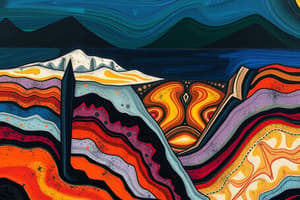Podcast
Questions and Answers
What is a rift valley?
What is a rift valley?
- A linear-shaped lowland created by geologic rift or fault (correct)
- A type of mountain range
- A highland area
- An oceanic trench
What is the Earth's inner core primarily made of?
What is the Earth's inner core primarily made of?
Iron-nickel alloy and some light elements
What lies between the Earth's core and crust?
What lies between the Earth's core and crust?
Mantle
What is the outermost solid shell of a rocky planet called?
What is the outermost solid shell of a rocky planet called?
What defines the lithosphere?
What defines the lithosphere?
What is the asthenosphere?
What is the asthenosphere?
Convergent means two things going in different directions.
Convergent means two things going in different directions.
Divergent means going towards each other.
Divergent means going towards each other.
What does it mean to transform?
What does it mean to transform?
What is subduction?
What is subduction?
What is a tectonic plate?
What is a tectonic plate?
What was continental drift?
What was continental drift?
What is Pangaea?
What is Pangaea?
Flashcards are hidden until you start studying
Study Notes
Rift Valley
- Linear lowland between highlands or mountain ranges.
- Created by geological rifting or fault action at divergent plate boundaries.
- Formed through crustal extension leading to the drop of a center block, resulting in steep walls.
- Evolves into wider valleys and basins filled with sediment over time.
- Example: East African Rift.
Inner Core
- Earth's innermost part, primarily a solid ball.
- Approximately 1,220 km (760 miles) in radius.
- Composed mainly of an iron-nickel alloy with some lighter elements.
Mantle
- Layer between the core and crust in terrestrial planets.
- Formed through planetary differentiation by density.
- Composed of silicate rock in Earth, Venus, Mars, and Mercury, as well as some of Jupiter's moons.
- Other celestial bodies like Titan and Triton may have a mantle of ice or solid volatiles.
Crust
- Outermost solid shell of rocky bodies, distinct from the mantle.
- Formed primarily through igneous processes.
- Rich in incompatible elements compared to underlying mantles.
Lithosphere
- Rigid outer shell of a terrestrial planet, including crust and elastic upper mantle.
- Defined by mechanical properties rather than chemical composition.
Asthenosphere
- Layer of Earth’s mantle beneath the lithosphere.
- Much hotter and more fluid, extending from 100 km (60 miles) to about 700 km (450 miles) below the surface.
Convergent
- Describes two entities moving towards one another.
Divergent
- Describes entities moving in different directions.
Transform
- Refers to undergoing a dramatic change or transformation.
Subduction
- Horizontal and downward movement of an edge of a tectonic plate into the mantle beneath another plate.
Tectonic Plate
- Large, irregularly shaped slabs of solid rock, including both continental and oceanic lithosphere.
- Sizes vary significantly; large examples include the Pacific and Antarctic Plates.
Continental Drift
- Theory postulated by Alfred Wegener in 1912 explaining the movement of continents.
- Accounts for similarities in fossils and rock formations across different continents.
Pangea
- A supercontinent that existed 300 million years ago during the late Paleozoic and early Mesozoic eras.
- Formed from earlier continental units and began breaking apart about 175 million years ago.
Studying That Suits You
Use AI to generate personalized quizzes and flashcards to suit your learning preferences.



